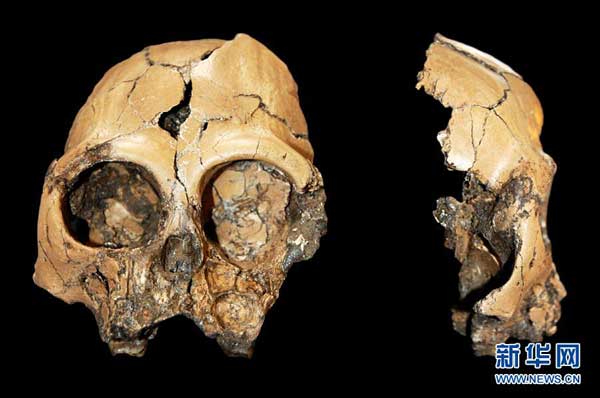Ape fossil may shed light on human origins
 0 Comment(s)
0 Comment(s) Print
Print E-mail Xinhua, September 6, 2013
E-mail Xinhua, September 6, 2013
|
This is only the second recovered cranium belonging to a juvenile ape inhabiting Eurasia in the Miocene that dates back to 23 to 5 million years ago.[File photo] |
Paleontologists hope a 6-million-year-old fossilized cranium of a juvenile ape unearthed in southwest China's Yunnan Province may help unravel the mystery of human origins.
This is only the second recovered cranium belonging to a juvenile ape inhabiting Eurasia in the Miocene that dates back to 23 to 5 million years ago, Ji Xueping, a researcher who led the study, told a news conference yesterday.
"The skull has great significance in research on our ancestors, as the time when the primate lived was close to that of the first humans, estimated at between 7 million to 5 million years ago," said Ji, from the Yunnan Institute of Cultural Relics and Archaeology.
"In Africa, a number of fossils of ancient primates of that age have been found, but such finds are scarce in Asia. From this perspective, the discovery is quite important," said Lu Qingwu, a professor with Institute of Vertebrate Paleontology and Paleoanthropology, Chinese Academy of Sciences.
A detailed description of the fossil was published in the "Chinese Sciences Bulletin" last month, nearly four years after Ji and colleagues found it in a pit owned by a brick factory in Shuitangba, Zhaotong City.
Largely undistorted
The age of the fossil ape, a member of the genus Lufengpithecus, was identified as between 6.2 to 6.1 million years ago, late in the Miocene epoch, which extended from about 23 million years ago to around 5.3 million years ago.
The cranium has maintained most of the facial skeleton and is largely undistorted, providing valuable information about the morphology of Lufengpithecus, said the study.
"The study shows the primate bears some features in common with humans. An example is that the width of its eye socket is longer than the height, just like us," said Lu.
The new find suggests a connection with the first humans in terms of timing and morphology. But Ji noted, "We still lack adequate fossil evidence to clarify its relationship with early hominins."
Cradle of ancestry
"In recent years, some scholars have proposed that Asia, rather than Africa, is the cradle of human ancestry based on recent findings. There's a lot more work ahead to explore such possibilities," said Lu.
Lufengpithecus is a collective name for fossil apes recovered in Kaiyuan, Lufeng, Yuanmou and Zhaotong in Yunnan since the 1950s. These date back between 11 million and 7 million years ago, .
It survived in Yunnan when extinct elsewhere, said Ji.
In the late Miocene, the hot, humid climate as well as lush tropical and subtropical forests in today's southwest China might provide an environment for human origins, said Ji. "Yunnan is a possible site to unravel the mystery."
Nina Jablonski from Pennsylvania State University co-led the study.







Go to Forum >>0 Comment(s)